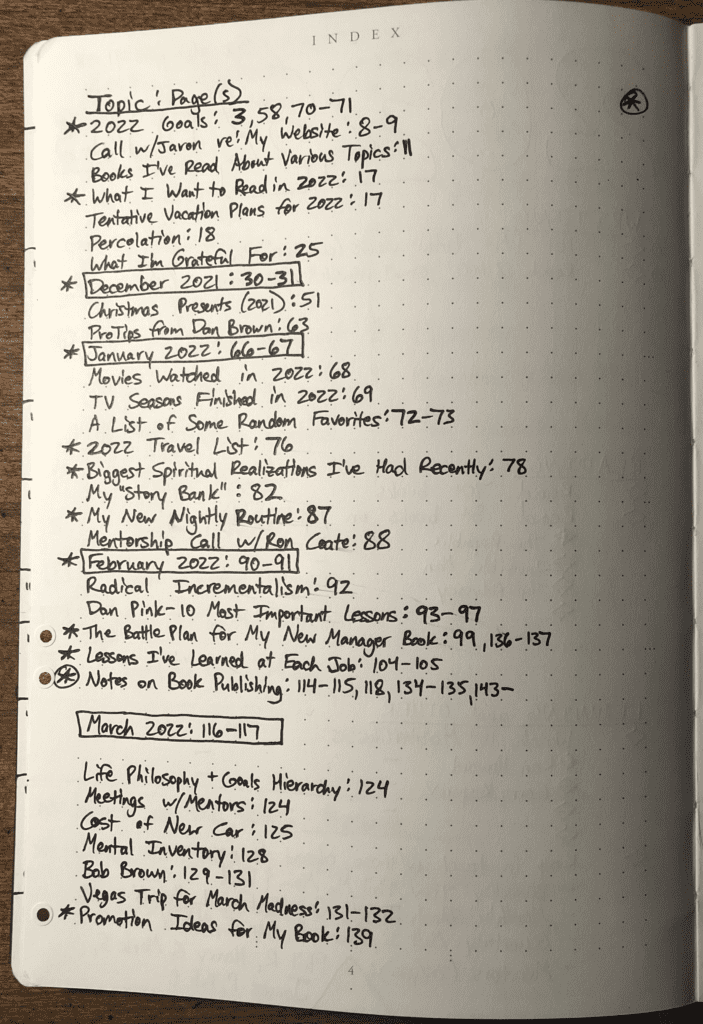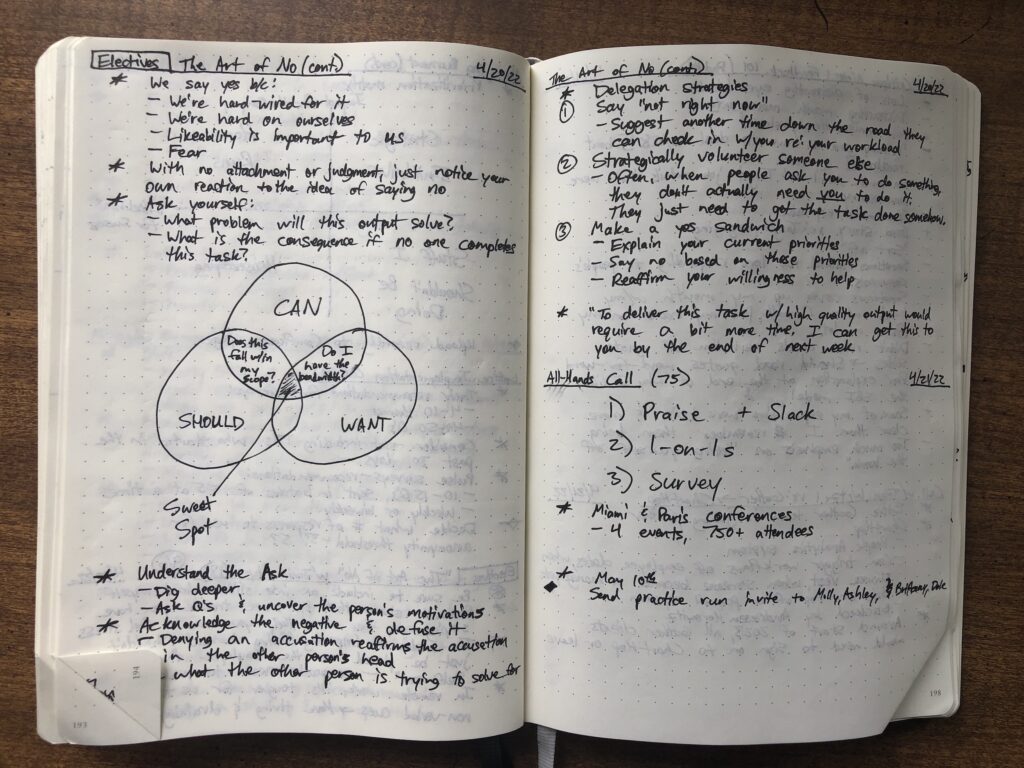After 15 Years of Trying to Build a Journaling Habit, I Finally Broke Through When I Tried the “BuJo” System

I was always better at buying journals than using them.
From the ages of 10 through 25, every time I saw a cool-looking journal at Wal-Mart or Target, I’d snag it with the optimistic intention of starting a journaling habit. After all, I’d always heard that journaling was a good way to self-reflect and that “When I was old someday, I’d be thankful to have those memories” (as the octagenarians at my church frequently told me).
So I figured I could propel myself into the habit by buying a kick-ass journal.
But alas, every time I tried to start journaling, my effort resulted in the same sad output: a notebook that contained 5–10 scribbled pages of boyish enthusiasm followed by 200 blank pages that reminded me how much I sucked at this whole journaling thing.
And so it went.
Journal after journal.
Year after year.
The only thing I had to show for my efforts was a bookshelf of awesome journals filled with not-so-awesome blank pages.
By the time I turned 30, I figured I wasn’t a journaling person.
The Journaling Challenge
Then, three years ago, my company ran a wellness challenge incentivizing every employee to practice self-reflection by journaling every day for two months. While discussing the challenge, my friend Christoph mentioned he had started using a system called “bullet journaling” (BuJo).
I learned that bullet journaling had a cult following online. Hundreds of Instagram accounts repped #bujo journaling products while thousands of people posted pictures of the fancy lettering and hand-drawn designs in their journals.
Those concepts didn’t appeal much to me, but something about BuJo did sound appealing. Christoph talked about how the system was flexible and could be tailored to suit many different preferences.
During my previous forays into journaling, one of the biggest issues I had encountered was that I couldn’t figure out a good way to group similar notes together. I’d write down an idea on page 2 of my journal, then think of something else to add onto that idea when I was on page 6. But I didn’t have any good way to string those notes together or find them quickly.
Christoph explained that BuJo had multiple solutions for that problem. He outlined a few of the basics and what had been helpful for him, so I decided to give it a shot.
Bullet Journaling (BuJo) Basics
I learned that the BuJo framework could be broken down into five core components:
- The Index: A handy quick reference guide showing which page(s) contained each main topic you wrote about
- The Daily Log: Your catch-all log of what happened each day
- The Monthly Log: Your list of activities going on this month
- The Future Log: Your list of activities going on beyond this month
- Collections: Random records of anything you want to track
BuJo creator Ryder Carroll describes BuJo as much more than a journaling practice. He calls it “a mindfulness practice disguised as a productivity system. It helps you organize WHAT you’re doing while keeping you mindful of WHY you’re doing it.”
Carroll provides an excellent overview of his system in this 4-minute video:
Modifying BuJo to Fit Your Needs
As I mentioned, I think the biggest benefit of BuJo is its flexibility. As an example of that flexibility, I don’t even use one of the core components mentioned above: the Future Log. I tried it for a while, but it didn’t work well for my workflow, so I axed it.
I’ve also modified all of the other components to align with my preferred note-taking style and how I get things done. I encourage you to do the same.
Let’s take a quick look at each one of the four core BuJo elements I use and walk through how each can help you organize your thoughts.
#1 — The Index
In my previous journals, it was a nightmare to find specific notes later—or, at least, it would have been if I ever wrote more than 20 pages in each journal before quitting. Any time I jotted down a meaningful note that I wanted to reference later, I didn’t have a good way of signaling where it could be found.
Enter the Index. Every bullet journaler usually reserves the first 2–4 pages of their notebook for the Index. This section is used to jot down the relevant page number(s) of any important notes, collections, etc.
Here’s a quick peek at the index of my current journal:

Now, whenever I want to locate notes from my last meeting with one of my mentors, add another movie to my list of film favorites, or refer back to an idea about the book I’m writing, I can quickly locate the relevant page number.
#2 — The Daily Log
The Daily Log is where most of the action happens in the journal. It’s where you write down your random observations, thoughts, events, and memories from the day.
Now, before you can truly understand the power of the Daily Log, you first need to understand the BuJo concept of “signifiers.” A signifier is any little symbol or notation that helps you separate various types of notes.
I use a BUNCH of signifiers because I’ve found them to be a useful way of quickly tracking down the type of entry I want to find at a given point in time.
Unlike most bullet journalers, I put my signifiers in two different columns depending on what type of note they pertain to. I reserve the far-left column for strategic notes (e.g., big-picture ideas, projects, lessons learned) and use the second column for tactical notes (e.g., daily minutiae, gratitudes, new vocabulary words).
Here are the signifiers I use:

You don’t need to understand what all this stuff means. These signifiers are meant for me—not you. But the general principle here is that you can create symbols to indicate the various types of entries you plan to jot down in your journal, then use those symbols to quickly find notes later.
Here’s how it all comes together in a Daily Log page:

There’s a lot going on here, and you don’t have to pay attention to most of it. I’ll just call your attention to a few key things numbered above…
- Beginning of Daily Log: Near the lower-left corner of the picture, you’ll see a headline that says “1/24/22 Monday.” That’s the format I use to begin each day’s log. I try to start most of my entries with three gratitudes, signified by the up arrows. You’ll also see a little stick figure, which is my signifier for exercise.
- Standard Note: In the upper-right part of the page, you’ll see my standard type of note. I use an asterisk as my top-level note and a dash as my sub-level note, so all of the indented dashes are basically bullet points of the top idea.
- Quotes: I love quotes, so I pepper them throughout my journal. The quotes you can see in the picture are from the book I was reading at the time: One Thousand Weeks by Oliver Burkeman. (Btw, that book is excellent, so you should check it out.)
- Weekly Goals: Now that we’ve reviewed a couple of the basic entries I use, direct your attention to the upper-left part of the picture. Every week, I set personal goals for things I’d like to accomplish. I usually try to set goals for books to read, friends to reconnect with, things to learn, etc.
- Vocab Words: Lastly, in the middle of the left-hand page, you’ll see a weird symbol that looks like a backward pilcrow (¶). That’s the signifier I use to indicate new vocabulary words I stumble across when I’m reading.
In case you couldn’t tell, I put a bunch of random types of notes in my journal—yes, even nerdy vocab words.
Here’s a brief sample of the types of things I record in my bullet journal:
- Notes/takeaways from MasterClasses, TED talks, and conferences
- Topics I realize I don’t know much about that I want to investigate further
- Ideas for future articles or books
- Inspirational sayings
- Action items
Whatever is important to YOU should go in your journal. If you want to primarily use it for recording what happened in your day, that’s great. But if you also want to pepper in other notes, ideas, quotes, Bible verses, observations about nature, or anything else, go for it! Make it your own.
The “bullet” part of bullet journaling refers to speed. One of the reasons BuJo is such an easy way to build a journaling habit is because it’s based on jotting down quick thoughts (like bullet points) rather than rambling paragraphs.
#3—The Monthly Log
The traditional way of writing a Monthly Log in BuJo is to simply record a list of the events going on that month and the action items you want to complete that month.
As with every other aspect of my bullet journal, I’ve modified the standard BuJo format to my needs by making a number of changes.
My Monthly Log always covers a two-page spread. On the first page, I record a list of all the things I have going on that month. It looks like this:

Note: I’ve blurred out some items to protect the confidentiality of a couple of my friends and specific events from that month.
At the start of every month, my Monthly Log begins as a blank list of numbers — one row for each day of the month. Then I gradually fill in a few of the upcoming events and details for the month.
But in addition to adding events in advance, I often add notes to a day’s record afterward to memorialize specific things from that day I may want to remember later. For example, there’s a random note on the 14th for “Walk in the rain” because that ended up being an unexpected highlight of my Monday.
And here’s what the second page of my Monthly Log looks like each month:

This page is based on the “don’t break the chain” productivity concept commonly attributed to Jerry Seinfeld. Here’s how comedian Brad Isaac described the concept:
[Seinfeld] said the way to be a better comic was to create better jokes and the way to create better jokes was to write every day.
He told me to get a big wall calendar that has a whole year on one page and hang it on a prominent wall. The next step was to get a big red magic marker. He said for each day that I do my task of writing, I get to put a big red X over that day.
“After a few days you’ll have a chain. Just keep at it and the chain will grow longer every day. You’ll like seeing that chain, especially when you get a few weeks under your belt. Your only job is to not break the chain.”
I realized I could track a dozen of the habits I most wanted to build and record X’s for how many days I actually practiced that habit, which would give me visibility into how my habits were developing over time.
My habit list contains everything from getting 7 hours of sleep per night to walking 10,000 steps per day.
Relationships are also super important to me, so on the far-right side of this Monthly Log page, I track the people with whom I got to spend quality time each day.
If you decide to incorporate this type of grid into your journaling practice, your habit list will look very different than mine. That’s great! Use it to track the things that are important to you.
#4—Collections
You can use BuJo Collections to track lists of anything you want. I’ve used Collections to track quarterly goals, topics I want to write about, ideas for book titles, lessons learned from past jobs, and a host of other things.
Here’s an example of what a Collection looks like:

I love reading books about psychology and behavioral economics, so I used this collection to track a list of psychological biases I read about in various books. Someday I’ll probably use this list to write an article about the topic.
And here’s another example of a Collection:

You’ll notice that I ran out of room on the page above. Before I stumbled across the BuJo system, that sort of thing would have really bothered me because I never knew how many pages to allocate to a specific list or topic, so I’d either end up with (A) blank pages in my notebooks or (B) disjointed pages in different parts of my notebook that both referred to the same topic.
But with BuJo’s Index system (described earlier), I don’t have that problem anymore.
When I start a collection, I allocate a single page to it. Once that page fills up, I start writing another page—wherever I am in the journal — and simply add that page number to my Index.
So, for example, when I kick off my annual goal planning at the start of each year, I can rest assured knowing that if I think of additional goals later, I can simply add those new Collection pages to my Index, as shown below:

Collections are one of my favorite parts of the BuJo system. They’re extremely versatile, and thanks to the Index at the beginning of each journal, they’re also really easy to find later.
Applying BuJo to Work
Now that I’ve been using BuJo for a few years, I’ve started to incorporate it into my work notebook as well. (I keep two separate notebooks: a personal one and a work one.)
Many of my same BuJo mechanisms carry over to my work notebook. For example, I use the same signifiers. (As you may have noticed in my signifiers picture earlier, I draw diamonds to denote action items. I color in the diamond once I complete the action item, which provides a nice little dopamine hit as I complete my work.)
But there are two key elements I incorporate into my work notebook, distinct from my personal notebook.
The first is that I’ve found it useful to draw a physical calendar in my work notebook to track my most important daily action items and weekly projects. Here’s the start of my June calendar:

And the second thing I do in my work notebook is dog-ear a page once I’ve completed all of the action items on that page. I picked up this trick from an old boss of mine (thanks Annie!), and it works like a charm. Since I started doing this, I’ve hardly forgotten a single action item for years.
As you can see in the images below, it’s really easy to tell which pages have uncompleted action items. So I can quickly scan through the non-dog-eared pages to see which items are still outstanding and determine whether any of them are high enough priority to tackle that day.


Conclusion
As I’ve tried to express throughout this post, there are a million different ways to modify the BuJo concepts to your personal preferences. The specific mechanisms mentioned in this article have worked really well for me, and you’ll need to find the mechanisms that work best for you and your workflow.
But in general, I’ve been amazed by how useful BuJo has been in my life. It’s helped me retrospect more on my life, keep track of what’s going on, and document what I’m doing in ways that make me far more mindful and present than I’ve ever been.
If you have any follow-up questions, don’t hesitate to leave a comment below. Or, if you’ve already been using BuJo in your own life, please share your tips!
Happy journaling, friends.




How did advice from the older members of the writer’s church influence their desire to start journaling? Regard Akuntansi
I wouldn’t say it really swayed me, but that’s just one example of the types of recommendations I’ve received for why I should journal in the past.